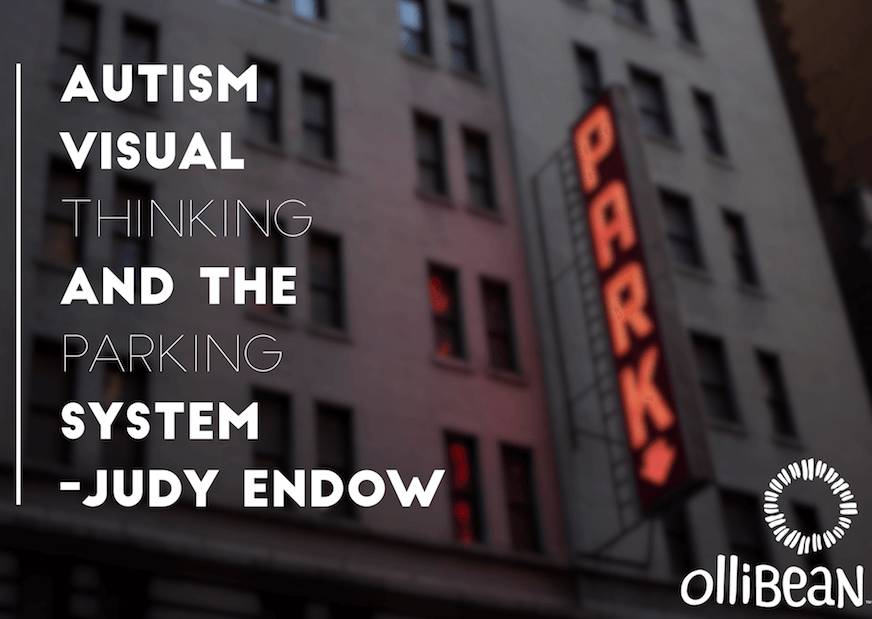Autism and Visual Thinking
Many autistic people think visually. As a young child who thought visually I was often thought to be stubborn and insisting upon my own way when in reality I was merely trying to keep ahold of a thought. Today in my work I come in contact with many on the spectrum and see the same phenomenon at work. Let me explain with two examples:
Example Parking Objects:
Every day Britt comes to school with a toy from home. It is very difficult for her to leave the toy in her cubby so she carries it with her. Sometimes this works out ok; other times it poses problems such as when the toy is large or makes noise or is something other children want to play with. Whenever someone attempts to put the toy in her cubby or elsewhere Britt falls to floor crying loudly and becomes inconsolable.
Britt is a visual thinker. When an object is out of site, it was as if it were lost forever because she could no longer see it. We used a bright piece of construction paper placed by her cubby for Britt to use as a parking space. She put her toy in this garage and we took a picture of the toy in the garage. After printing the picture we held the picture next to the garage with the toy parked in it so Britt could see the picture was the same as the toy parked in the garage.
Next we played a game. We gave Britt the picture of Minnie Mouse in the garage to hold. We asked, “Where is Minnie Mouse?’ Britt could see both the real Minnie Mouse sitting in the garage and the picture of Minnie Mouse in the garage. Next we turned our back to the garage and asked, “Where is Minnie Mouse?” Britt could see the picture of Minnie Mouse in the garage. We increased the distance between the garage and Britt. As long as she was holding the picture she could see Minnie Mouse and know Minnie Mouse was in the garage.
In a few days the picture of toy in garage was printed smaller and attached to the bottom of Britt’s visual schedule. Britt did not yet understand to make the picture in her head, but she this strategy has served her well for several months now because it supports her visual style of thinking, allowing her to be separated from favorite toys.
Example of Parking Thoughts:
Each weekday morning Eli’s grandmother picked him up. On Monday, Wednesday and Friday she brought him to preschool. On Tuesday and Thursday they went to grandma’s house. Each morning at breakfast mom would tell Eli if it was a school day or a grandma’s house day. If Eli thought he was going one place and it turned out he was going the other place he had a meltdown and had trouble the rest of the day.
Eli was a visual thinker. When he thought he was going to grandma’s house and it was a preschool day he had no way to hold his thought – i.e., he had no where to put his visual thought for safe-keeping until the time he needed to retrieve it. As a visual thinker, this meant he had to hold onto the picture of the activities he had in mind to do at grandma’s house until the next day when he could actually go to grandma’s house. In order to hold onto this picture he was unable to fully engage in today’s activities. Furthermore, everything he did in his today was a mismatch to the picture in his head (activities at grandma’s house). This mismatch precipitated intermittent crying and throwing of objects throughout the day.
This often happens with visual thinkers. When thoughts are pictures you need to keep seeing them in order to not forget them. Often this leads to behavior that doesn’t work well. In this case Eli was not able to engage in any of his school activities and spent time crying and throwing things. The whole time he was at school he talked about being at grandma’s house and what he was going to do at grandma’s house.
Visual Schedule
Eli had been using a daily visual schedule. Drawing on his familiarity, we used a small dry erase board, labeling it Another Day. I started drawing with a dry erase pen each of the things he talked about. For example, he talked about playing Candy Land, eating goldfish crackers, cheese and grapes and swinging outside at grandma’s house.
Once these things were drawn on the page labeled Another Day this page was placed next to his visual schedule. This allowed Eli to know he could return to his thoughts about what he would do at grandma’s house whenever he wished. He knew where to look. This meant he no longer had to keep the picture in his head. Thus, he was able to engage with the activities on the visual school schedule. Periodically, he go over his schedule, point to the dry erase board and “read” the pictures, reciting aloud what he would do Another Day at grandma’s house. Occasionally he would add a picture item. Thus, Eli learned a system for how to park a visual thought in a way that worked with his visual thinking. This allowed him to engage in the activities at hand because he knew he would not lose his thoughts and plans for grandma’s house.
Conclusion:
There are many ramifications of thinking visually. Often, children on the spectrum can benefit when we understand how their thinking works and give them visual strategies compatible with thinking style. Always remember to consider the impact of visual thinking when unproductive behavior emerges.
BOOKS AND DVD BY JUDY ENDOW
Endow, J. (2012). Learning the Hidden Curriculum: The Odyssey of One Autistic Adult. Shawnee Mission, KS: AAPC Publishing.
Endow, J. (2006). Making Lemonade: Hints for Autism’s Helpers. Cambridge, WI: CBR Press.
Endow, J. (2013). Painted Words: Aspects of Autism Translated. Cambridge, WI: CBR Press.
Endow, J. (2009a). Paper Words: Discovering and Living With My Autism. Shawnee Mission, KS: AAPC Publishing.
Endow, J. (2009b). The Power of Words: How we think about people with autism spectrum disorders matters! Shawnee Mission, KS: AAPC Publishing.
Endow, J. (2009c). Outsmarting Explosive Behavior: A Visual System of Support and Intervention for Individuals With Autism Spectrum Disorders. Shawnee Mission, KS: AAPC Publishing.
Endow, J. (2010). Practical Solutions for Stabilizing Students With Classic Autism to Be Ready to Learn: Getting to Go. Shawnee Mission, KS: AAPC Publishing.
Myles, B. S., Endow, J., & Mayfield, M. (2013). The Hidden Curriculum of Getting and Keeping a Job: Navigating the Social Landscape of Employment. Shawnee Mission, KS: AAPC Publishing.










This is also a reason for my apparent hoarding behavior and disorganization as an adult. If things are put away in a socially acceptable manner, my brain cannot readily accept that I still have those things available to me or even remember they exist. So I buy more when I don’t really need it instead of getting it out of its proper place that I cannot remember, and have everything out everywhere so I can see it, which unfortunately often fails when there is too much stuff and things become buried under other things. I wonder if drawing a kind of map of my storage might be an idea that would work for at least some things.
I like your writing. It is very useful.
It would be great if you did a blog on “asking for accommodations” particularly the part where the person may (or may not) be willing to do the thing you asked them (if they feel like it or think it is actually reasonable to give it to you). Sometimes, even often, it doesn’t seem to be worth the trouble. Work is hard but asking family and friends is in a whole other league of difficult (at least if you were diagnosed as an adult).
Keep up the great work.
I just recently found your site.. And can’t say thank you enough for all you have shared..
I’m a grandmother, raising my grandson who is on the spectrum. And I’m trying to learn anyway possible of the things that could help him with his day to day activities..
Him being non verbal comes with great frustration, I can see it, he has so much he wishes to communicate to me but, can’t.
Thank you, from both myself and my grandson
I love this writing! Great ideas. I keep trying to tell people about this stuff but I never put it this well!